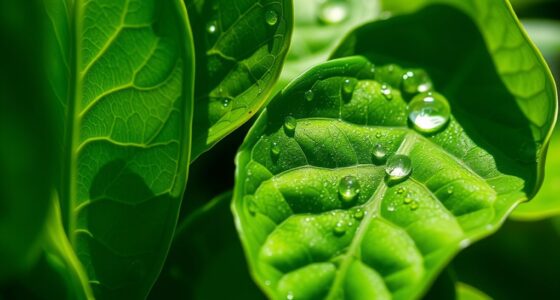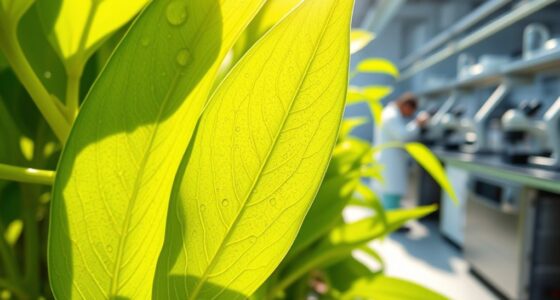During summer, soil microbes in your rhizosphere support plant health by aiding nutrient cycling and disease resistance. However, heat and drought threaten these beneficial microbes, reducing their diversity and disrupting their functions. This makes your plants more vulnerable to stresses and pests. Drought-resistant microbes can adapt, but overall, microbial diversity decreases, destabilizing soil health. Keep exploring to learn how management practices can help protect and boost your soil’s microbial resilience during tough environmental conditions.
Key Takeaways
- Heat and drought reduce microbial diversity, decreasing beneficial microbes that support nutrient cycling and plant health.
- Drought conditions favor drought-resistant microbes, shifting community composition in the rhizosphere.
- Microbial populations may decline or perish under prolonged dry spells, weakening soil ecosystem functions.
- Microbes adapt by forming biofilms and producing protective compounds to survive heat and drought stress.
- Management practices like mulching and cover cropping enhance microbial resilience and maintain rhizosphere health during summer.

Have you ever wondered what happens beneath the soil’s surface during summer? The answer lies in the bustling community of soil microbes that thrive in the rhizosphere—the zone surrounding plant roots. During the hottest months, these tiny organisms face intense challenges from heat and drought, but they also play a crucial role in maintaining plant health and soil stability. One key aspect of their survival is microbial diversity. When conditions are favorable, a diverse microbial community flourishes, supporting nutrient cycling, disease suppression, and root growth. However, during summer droughts, this diversity can be threatened, as many microbes struggle to withstand prolonged dry spells. Still, some microbes adapt by developing drought resilience, allowing them to survive and even flourish under harsh conditions.
Soil microbes thrive in summer, supporting plant health and adapting to drought challenges.
Your soil’s microbial diversity acts as a buffer against environmental stress. When drought conditions set in, a rich variety of microbes can help sustain plant life by maintaining essential functions like nitrogen fixation and organic matter decomposition. These microbes form symbiotic relationships with roots, which can enhance a plant’s ability to access water and nutrients. In drought-resilient soils, certain microbial groups become dominant, producing protective compounds or forming biofilms that shield them from dehydration. This resilience isn’t just about survival; it actively supports the plant’s ability to cope with the stress, creating a more stable rhizosphere environment despite the challenging summer conditions. Research indicates that microbial diversity is a critical factor in soil health and overall ecosystem stability.
As temperatures rise and moisture levels drop, the microbial community shifts. Some microbes perish, reducing overall microbial diversity, while others adapt or migrate to more hospitable zones within the soil. This shift can influence plant health, making them more vulnerable to pests or diseases if beneficial microbes decline. Conversely, in soils with high microbial diversity and drought resilience, plants often fare better because their microbial partners continue to provide vital services. These resilient microbes help sustain nutrient exchange and protect roots from pathogens, even when water is scarce.
Understanding how microbial diversity and drought resilience interact during summer is key to managing soil health. Implementing practices like mulching, cover cropping, or reduced tillage can foster a more robust microbial community. These strategies help maintain moisture and organic matter, encouraging microbes to thrive and adapt to drought conditions. In turn, healthier, more resilient soils support stronger plants capable of enduring the summer’s heat and drought stresses. By nurturing soil microbes, you’re not just preserving tiny organisms—you’re strengthening the very foundation of your garden or farm, ensuring sustainability through the toughest seasons.
Frequently Asked Questions
How Do Soil Microbes Recover After Extreme Summer Droughts?
After extreme summer droughts, you can see soil microbes recover through microbial succession, where resistant species dominate first, helping restore soil health. Drought adaptation mechanisms enable microbes to survive harsh conditions, allowing them to bounce back when moisture returns. By fostering organic matter and minimizing disturbance, you support microbial recovery, ensuring the rhizosphere remains healthy and resilient for plant growth.
What Role Do Microbes Play in Plant Heat Tolerance?
Your understanding of plant microbe symbiosis reveals microbes’ vital role in heat resilience. Microbial adaptation helps microbes support plants by enhancing nutrient uptake and producing heat-shock proteins, boosting plant heat tolerance markedly. These tiny allies act like a superhero team, fortifying your plants against extreme temperatures. By fostering healthy microbial communities, you enable your plants to endure and thrive despite the scorching summer, making your garden virtually indestructible.
Can Microbial Diversity Predict Soil Resilience to Summer Stress?
You might wonder if microbial diversity can predict soil resilience to summer stress. Higher diversity promotes beneficial microbial interactions, which enhance soil enzymatic activity and nutrient cycling. These processes help soil withstand heat and drought, maintaining plant health. By monitoring microbial diversity, you can gauge the soil’s ability to recover from stress, making it a useful indicator of resilience. The more diverse the microbes, the better your soil’s chances of enduring summer challenges.
How Do Microbial Communities Vary Across Different Climate Zones?
Imagine walking through diverse landscapes, where microbial communities shift with each climate zone. You’d see lush forests, arid deserts, and temperate plains, each hosting unique microbial distributions. These variations reflect climate adaptation, shaping how microbes support plant health and soil resilience. Understanding these differences helps predict how microbial communities respond to environmental changes, guiding efforts to enhance soil health across regions. Climate zones truly mold microbial diversity in fascinating ways.
Are There Microbial Indicators for Soil Health During Summer?
You can identify microbial bioindicators that signal soil health during summer by examining specific soil health markers. Look for beneficial microbes like nitrogen-fixers and organic matter decomposers, which thrive in healthy soils. These microbial bioindicators respond to environmental stressors like heat and drought, making them useful in evaluating soil resilience. Regular monitoring of these markers helps you maintain ideal soil conditions and supports sustainable land management practices during challenging summer months.
Conclusion
As summer’s heat and drought challenge soil microbes, remember that a healthy rhizosphere is your garden’s backbone. Stay proactive—mulch, irrigate wisely, and avoid over-fertilizing to support microbial life. Keep in mind, “a stitch in time saves nine,” meaning early actions now prevent bigger problems later. By tending to your soil’s microbial health, you ensure lush, resilient plants that can withstand nature’s toughest tests.










